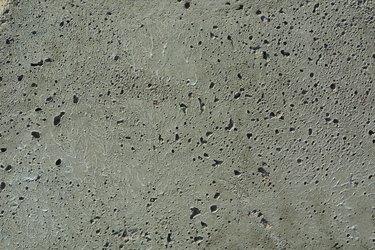
Laminate flooring in a home can completely revitalize an old look of a room, creating a classic style that matches many home decors. You can install laminate flooring over a variety of subfloors, including concrete. However, before you can begin to lay the floor boards, you must ensure that any damage to the concrete is completely repaired.
Reasons for Repairing
Video of the Day
The basic rules of laying laminate flooring dictate that the subfloor over which it is laid must be completely clean, flat and structurally sound. Cracks in the concrete will lead to an uneven surface for installation and will often produce dust that can contaminate the laminate and the material used to hold it in place. Also, cracks will potentially continue to grow larger under the added pressure of the laminate and can create a safety hazard if not addressed. And if the concrete has any moisture issues at all, cracks in the surface will allow more moisture to leak through.
Video of the Day
Products for Repair
You can use a variety of products to repair the cracks in your concrete. Hairline cracks will often only require an epoxy resin injection, which will spread into the thin area better than any material you could apply to the surface. Larger cracks require a patching compound; hardware stores sell these materials in bags that require you just to add water. You can also make your own patching compound. For smaller cracks, mix one part Portland cement and two and a half parts fine sand; for larger cracks, use one part cement, two parts fine sand and three parts gravel.
Cleaning the Cracks
Ensuring that the cracks are completely clean before repair is key to ensuring that the repair work will hold. Use a chisel and hammer to undercut the crack, meaning that you cut it into an inverted "V" shape so that the base is at least 1 inch wider than the top of the crack, which will ensure that the patching compound has a solid place to flow and bond, establishing a stronger hold. Remove all dust and debris from the crack with a wet/dry vacuum or a can of condensed air. The final preparation step is to paint the crack, as well as the surface surrounding the crack extending 1 inch in all directions, with concrete bonding compound, which will help the patching material stick in place.
Methods of Repair
Once the crack is prepped, the repair work can begin. In general, using a trowel is the best and most accurate way to apply patching compound. Use the pointed end, or a masonry pointing tool, to force the patching compound into the crack. Overfill the crack slightly, and scrape the flat edge of the trowel across the surface to flatten it out. You must keep the patchwork dry for at least five days, so you will need to cover it with plastic or wood protection. Lift the protection once per day to mist the top so that the concrete cures slow and strong.